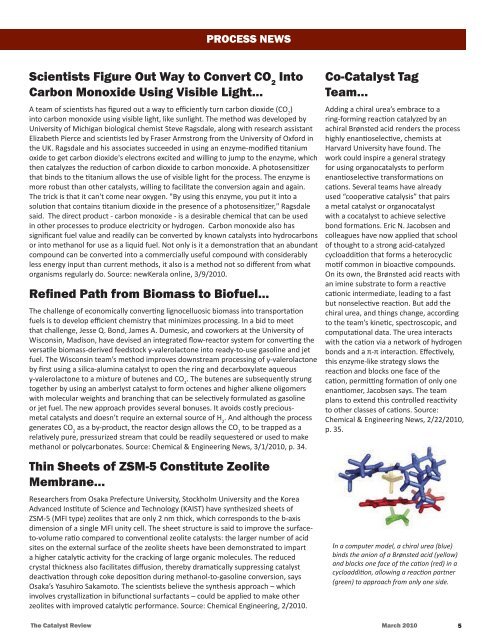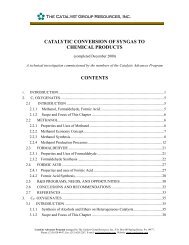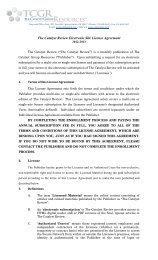THE CATALYST REVIEW - The Catalyst Group
THE CATALYST REVIEW - The Catalyst Group
THE CATALYST REVIEW - The Catalyst Group
Create successful ePaper yourself
Turn your PDF publications into a flip-book with our unique Google optimized e-Paper software.
PROCESS NEWS<br />
Scientists Figure Out Way to Convert CO 2<br />
Into<br />
Carbon Monoxide Using Visible Light…<br />
A team of scientists has figured out a way to efficiently turn carbon dioxide (CO 2<br />
)<br />
into carbon monoxide using visible light, like sunlight. <strong>The</strong> method was developed by<br />
University of Michigan biological chemist Steve Ragsdale, along with research assistant<br />
Elizabeth Pierce and scientists led by Fraser Armstrong from the University of Oxford in<br />
the UK. Ragsdale and his associates succeeded in using an enzyme-modified titanium<br />
oxide to get carbon dioxide's electrons excited and willing to jump to the enzyme, which<br />
then catalyzes the reduction of carbon dioxide to carbon monoxide. A photosensitizer<br />
that binds to the titanium allows the use of visible light for the process. <strong>The</strong> enzyme is<br />
more robust than other catalysts, willing to facilitate the conversion again and again.<br />
<strong>The</strong> trick is that it can't come near oxygen. "By using this enzyme, you put it into a<br />
solution that contains titanium dioxide in the presence of a photosensitizer," Ragsdale<br />
said. <strong>The</strong> direct product - carbon monoxide - is a desirable chemical that can be used<br />
in other processes to produce electricity or hydrogen. Carbon monoxide also has<br />
significant fuel value and readily can be converted by known catalysts into hydrocarbons<br />
or into methanol for use as a liquid fuel. Not only is it a demonstration that an abundant<br />
compound can be converted into a commercially useful compound with considerably<br />
less energy input than current methods, it also is a method not so different from what<br />
organisms regularly do. Source: newKerala online, 3/9/2010.<br />
Refined Path from Biomass to Biofuel…<br />
<strong>The</strong> challenge of economically converting lignocelluosic biomass into transportation<br />
fuels is to develop efficient chemistry that minimizes processing. In a bid to meet<br />
that challenge, Jesse Q. Bond, James A. Dumesic, and coworkers at the University of<br />
Wisconsin, Madison, have devised an integrated flow-reactor system for converting the<br />
versatile biomass-derived feedstock γ-valerolactone into ready-to-use gasoline and jet<br />
fuel. <strong>The</strong> Wisconsin team’s method improves downstream processing of γ-valerolactone<br />
by first using a silica-alumina catalyst to open the ring and decarboxylate aqueous<br />
γ-valerolactone to a mixture of butenes and CO 2<br />
. <strong>The</strong> butenes are subsequently strung<br />
together by using an amberlyst catalyst to form octenes and higher alkene oligomers<br />
with molecular weights and branching that can be selectively formulated as gasoline<br />
or jet fuel. <strong>The</strong> new approach provides several bonuses. It avoids costly preciousmetal<br />
catalysts and doesn’t require an external source of H 2<br />
. And although the process<br />
generates CO 2<br />
as a by-product, the reactor design allows the CO 2<br />
to be trapped as a<br />
relatively pure, pressurized stream that could be readily sequestered or used to make<br />
methanol or polycarbonates. Source: Chemical & Engineering News, 3/1/2010, p. 34.<br />
Thin Sheets of ZSM-5 Constitute Zeolite<br />
Membrane…<br />
Researchers from Osaka Prefecture University, Stockholm University and the Korea<br />
Advanced Institute of Science and Technology (KAIST) have synthesized sheets of<br />
ZSM-5 (MFI type) zeolites that are only 2 nm thick, which corresponds to the b-axis<br />
dimension of a single MFI unity cell. <strong>The</strong> sheet structure is said to improve the surfaceto-volume<br />
ratio compared to conventional zeolite catalysts: the larger number of acid<br />
sites on the external surface of the zeolite sheets have been demonstrated to impart<br />
a higher catalytic activity for the cracking of large organic molecules. <strong>The</strong> reduced<br />
crystal thickness also facilitates diffusion, thereby dramatically suppressing catalyst<br />
deactivation through coke deposition during methanol-to-gasoline conversion, says<br />
Osaka’s Yasuhiro Sakamoto. <strong>The</strong> scientists believe the synthesis approach – which<br />
involves crystallization in bifunctional surfactants – could be applied to make other<br />
zeolites with improved catalytic performance. Source: Chemical Engineering, 2/2010.<br />
Co-<strong>Catalyst</strong> Tag<br />
Team…<br />
Adding a chiral urea’s embrace to a<br />
ring-forming reaction catalyzed by an<br />
achiral Brønsted acid renders the process<br />
highly enantioselective, chemists at<br />
Harvard University have found. <strong>The</strong><br />
work could inspire a general strategy<br />
for using organocatalysts to perform<br />
enantioselective transformations on<br />
cations. Several teams have already<br />
used “cooperative catalysis” that pairs<br />
a metal catalyst or organocatalyst<br />
with a cocatalyst to achieve selective<br />
bond formations. Eric N. Jacobsen and<br />
colleagues have now applied that school<br />
of thought to a strong acid-catalyzed<br />
cycloaddition that forms a heterocyclic<br />
motif common in bioactive compounds.<br />
On its own, the Brønsted acid reacts with<br />
an imine substrate to form a reactive<br />
cationic intermediate, leading to a fast<br />
but nonselective reaction. But add the<br />
chiral urea, and things change, according<br />
to the team’s kinetic, spectroscopic, and<br />
computational data. <strong>The</strong> urea interacts<br />
with the cation via a network of hydrogen<br />
bonds and a π-π interaction. Effectively,<br />
this enzyme-like strategy slows the<br />
reaction and blocks one face of the<br />
cation, permitting formation of only one<br />
enantiomer, Jacobsen says. <strong>The</strong> team<br />
plans to extend this controlled reactivity<br />
to other classes of cations. Source:<br />
Chemical & Engineering News, 2/22/2010,<br />
p. 35.<br />
In a computer model, a chiral urea (blue)<br />
binds the anion of a Brønsted acid (yellow)<br />
and blocks one face of the cation (red) in a<br />
cycloaddition, allowing a reaction partner<br />
(green) to approach from only one side.<br />
<strong>The</strong> <strong>Catalyst</strong> Review March 2010<br />
5






